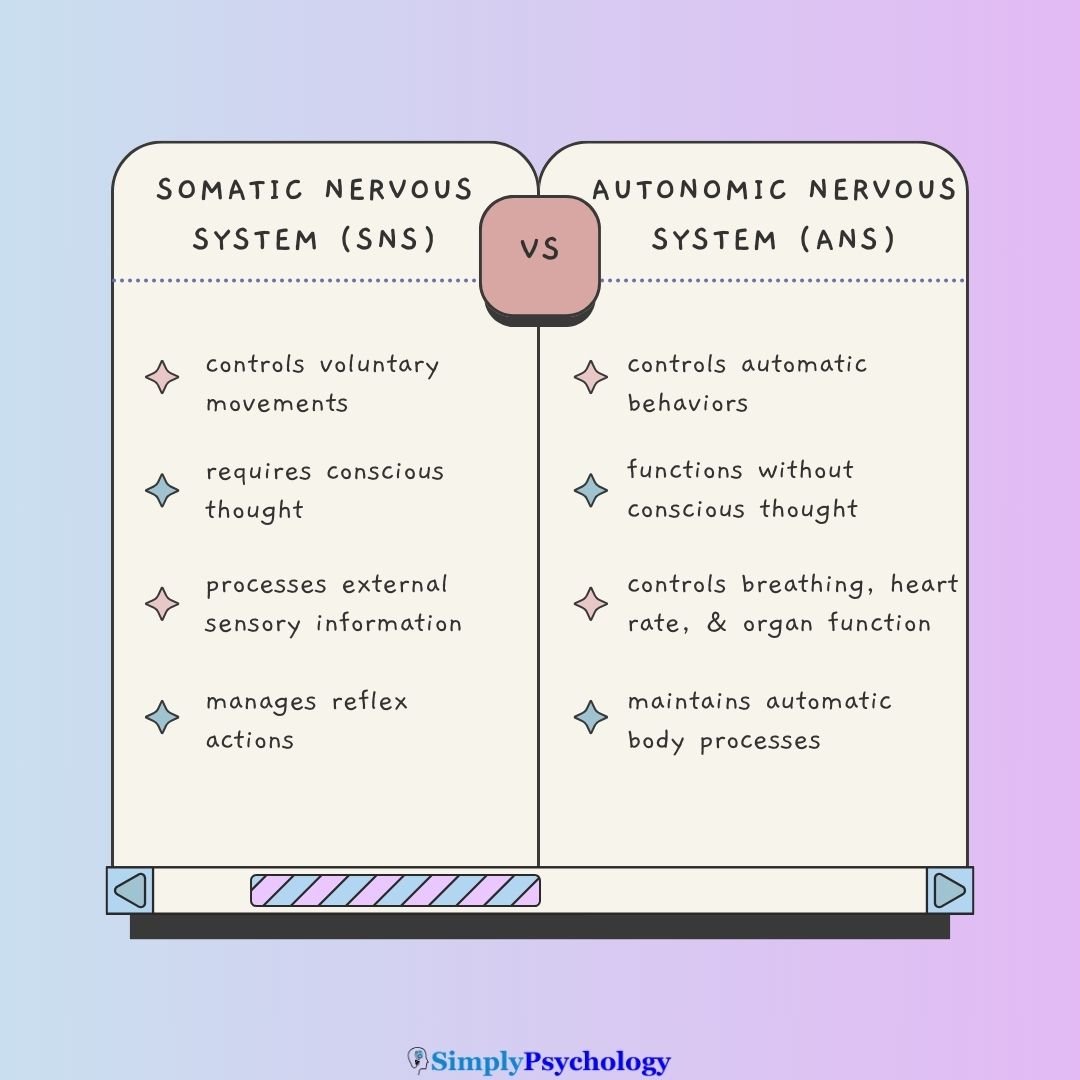The somatic nervous system (SNS) is part of the peripheral nervous system, which connects the brain and spinal cord (central nervous system) to the rest of your body.
Unlike the autonomic nervous system—which handles automatic functions like heart rate and digestion—the somatic nervous system controls actions you do on purpose, like picking up a glass or tying your shoes.
The SNS is also responsible for carrying sensory information (like touch, pain, and temperature) from the body to the brain, helping you interpret and react to the world around you.

Key Takeaways
- The somatic nervous system (SNS) controls voluntary movements like walking, talking, and reaching for objects.
- It processes sensory input—such as touch, temperature, and pain—and sends that information to the brain.
- The SNS uses sensory and motor neurons to communicate between the brain and the body.
- Reflex arcs allow the body to react quickly to danger without needing the brain’s involvement.
- Damage to the SNS can cause muscle weakness, numbness, and nerve pain, but healthy habits may reduce your risk.
Somatic Nervous System Function
The somatic nervous system has two primary jobs:
1. Processing Sensory Input
Sensory receptors in your skin, eyes, ears, nose, and tongue detect changes in your environment—such as heat, texture, sound, or light. This information travels through sensory (afferent) neurons to your brain, where it’s interpreted.
Example: When you touch a hot stove, sensory neurons send a message to your brain letting you know it’s painful.
2. Controlling Voluntary Movement
Once your brain processes this information, it sends signals through motor (efferent) neurons to your skeletal muscles. These signals instruct your body to move.
Example: After seeing a ball fly toward you, your brain sends a signal to your arm muscles to catch it.
How the Somatic Nervous System Works
Below is a step-by-step guide to how the somatic nervous system works:
- Detecting the Environment
Sensory receptors in places like your skin and eyes notice changes—like heat or light. - Creating a Signal
Sensory neurons generate electrical impulses that travel through your spinal nerves to the spinal cord. - Brain Processing
The brain receives and interprets the signals and decides how to respond. - Sending a Response
Motor neurons carry the brain’s instructions back down the spinal cord to your muscles. - Muscle Activation
The targeted skeletal muscles contract, completing the voluntary actio
Reflex Arcs
Not all movements need the brain’s involvement. Sometimes, the body reacts so quickly that the brain isn’t part of the loop—this is called a reflex arc.
A reflex arc allows your body to respond to danger immediately. Instead of going all the way to the brain, sensory neurons send signals directly to the spinal cord, which quickly triggers a motor response.
Example: You accidentally touch something hot and pull your hand away before you even feel the pain.
Common reflexes include:
- Blinking when something flies toward your eye
- The knee-jerk reflex at the doctor’s office

Part of the SNS
- Sensory (Afferent) Neurons: Carry signals from sensory receptors to the brain and spinal cord.
- Motor (Efferent) Neurons: Deliver signals from the brain and spinal cord to muscles.
- Ganglia: Clusters of neuron cell bodies located outside the brain and spinal cord.
- Glial Cells: Support cells that help neurons function effectively.
- Nuclei: Collections of neuron cell bodies in the central nervous system with a shared function.

Somatic vs. Autonomic nervous system
The SNS and the autonomic nervous system (ANS) are both part of the peripheral nervous system (PNS), but they have different functions:
| Somatic Nervous System (SNS) | Autonomic Nervous System (ANS) |
|---|---|
| Controls voluntary movements | Controls automatic behaviors |
| Requires conscious thought | Functions without conscious thought |
| Controls skeletal muscle movement | Controls breathing and heart rate |
| Processes external sensory information | Regulates internal organ function |
| Manages reflex actions | Maintains automatic body processes |
Working Together:
Both systems collaborate to maintain homeostasis (“homo-” meaning same and “-stasis” meaning state of equilibrium), with the SNS handling external responses to environmental changes while the ANS manages internal bodily functions.
For example, when experiencing cold (detected by SNS), the body can both move to a warmer place (SNS response) and adjust internal temperature regulation (ANS response).

What Happens If the Somatic Nervous System Is Damaged?
Since the SNS is essential for sensing the environment and moving your body, damage can lead to:
- Muscle weakness or loss of control
- Numbness or loss of sensation
- Sharp or burning nerve pain
Common causes of SNS damage include:
- Diabetes (leading to peripheral neuropathy)
- Injuries or trauma affecting nerves
- Autoimmune diseases (e.g., multiple sclerosis)
In motor neuron disease, the neurons that control muscles gradually die, causing weakness and muscle wasting.
In multiple sclerosis, the protective covering of nerves (myelin sheath) breaks down, disrupting communication between brain and body.

Can SNS Damage Be Prevented?
While some nerve disorders can’t be prevented, you can reduce your risk through:
- Eating a healthy, balanced diet
- Avoiding alcohol and tobacco
- Exercising regularly
- Treating vitamin deficiencies
These habits support nerve health and overall wellness.
References
Akinrodoye MA, Lui F. Neuroanatomy, somatic nervous system. StatPearls [Internet]. Treasure Island (FL): StatPearls Publishing. Updated April 2, 2020.
Cuevas, J. (2015). The Somatic Nervous System. Reference Module in Biomedical Sciences. Elsevier.
Dorland, W. A. N. (2011). Dorland’s Illustrated Medical Dictionary E-Book. Elsevier Health Sciences.
Fukudo, S. (2012). Hypothalamic-pituitary-adrenal axis in gastrointestinal physiology. In Physiology of the gastrointestinal tract (pp. 791-816). Elsevier Inc.
Rea, P. (2014). Introduction to the nervous system. Clinical Anatomy of the Cranial Nerves; Rea, P., Ed.; Academic Press: Cambridge, MA, USA.



